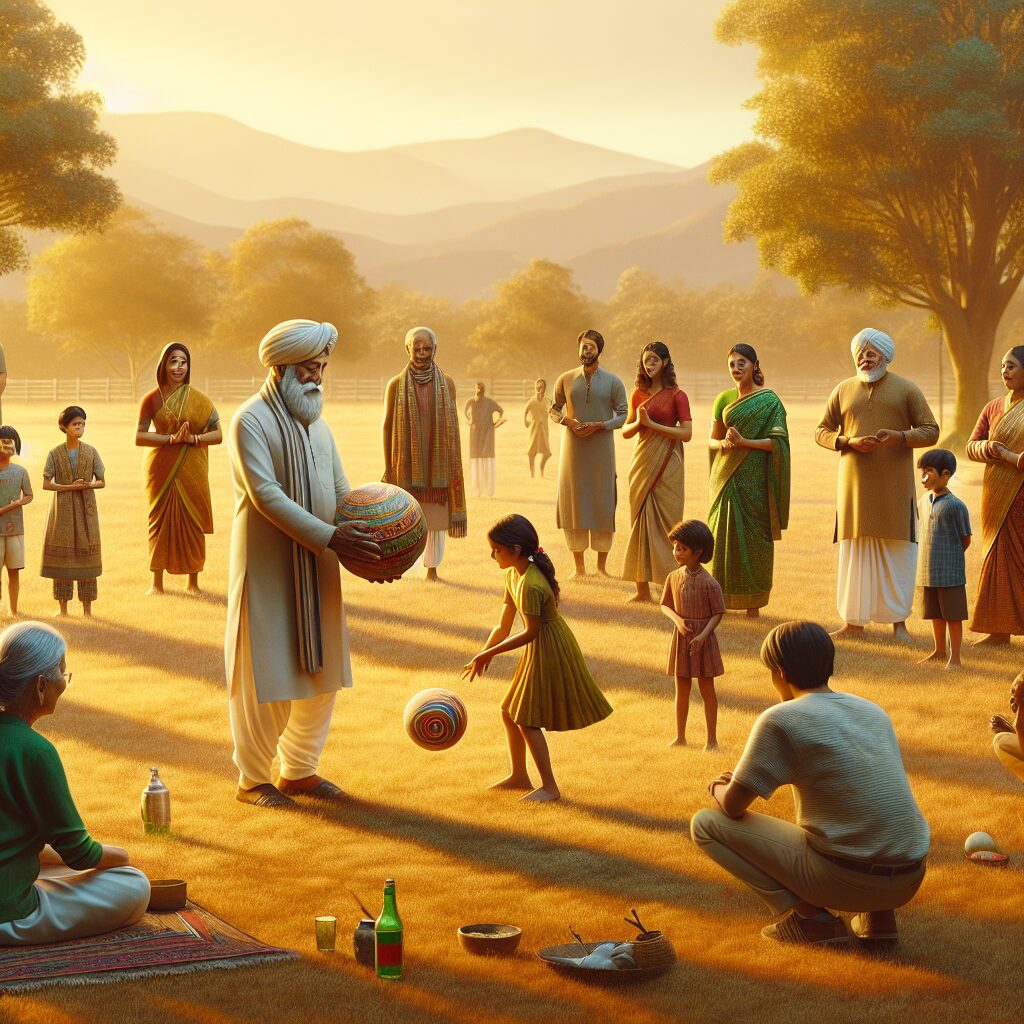Oral Tradition: Passing Down Ball Games Through Generations
Oral tradition refers to the transmission of knowledge, history, and cultural traditions through spoken word rather than written records. For centuries, communities across the world have relied on oral tradition to keep their heritage alive and preserve their unique customs. In this context, the passing down of ball games through generations is a fascinating example of how oral tradition has played a crucial role in preserving and disseminating cultural practices.
Ball games have long been a source of entertainment and a way to bring communities together. From the ancient Mayans’ sacred game of pok-ta-pok to the Native American tribes’ stickball, these traditional ball games have been cherished and passed down from one generation to the next. The unique feature of oral tradition in this context is its ability to ensure the retention of rules, techniques, and strategies involved in these games. By orally transmitting this knowledge, communities have been able to meticulously preserve the intricacies and nuances of these ball games, allowing future generations to carry on these traditions.
In the forthcoming sections of this article, we will explore the key takeaways from the practice of passing down ball games through generations. We will delve into the impact oral tradition has had on the preservation of cultural heritage and the significance of these games in fostering community cohesion. Additionally, we will discuss how modern advancements in technology and communication pose both challenges and opportunities for the continuation of this ancient practice. So, let us now embark on this enlightening journey, understanding the remarkable role of oral tradition in passing down ball games through generations.
Key Takeaways
1. Oral tradition plays a crucial role in passing down ball games from generation to generation, preserving cultural heritage and promoting community engagement.
2. In many Indigenous communities worldwide, ball games serve not only as a form of physical activity but also as a means of spiritual connection and cultural expression.
3. Through oral tradition, elders become teachers, sharing their knowledge and skills with younger generations, fostering a sense of identity and continuity within the community.
4. The transmission of ball games through oral tradition allows for flexibility and adaptation, allowing each generation to add their own elements and interpretations while honoring the fundamental rules and spirit of the games.
5. Oral tradition ensures the survival of ball games that might otherwise be lost in a rapidly changing world, providing a link to the past and a sense of collective memory for future generations.
How is Oral Tradition Keeping the Ball Games Alive Among Generations?
The Power of Oral Tradition
Oral tradition, as a powerful storytelling and knowledge-sharing tool, plays a vital role in passing down ball games through generations. For centuries, communities around the world have relied on the spoken word to preserve their cultural heritage and transmit important information from one generation to the next. This article explores how oral tradition is instrumental in preserving and perpetuating ball games.
Preserving Cultural Identity
Ball games hold immense significance in many cultures, serving as a reflection of their identity, values, and social dynamics. Through oral tradition, the rules, techniques, and history of these games are carefully preserved and passed down. Children learn about their ancestors’ traditions, their role in society, and the values associated with the games. Oral tradition ensures that cultural identities are not lost but rather celebrated and reinforced.
Facilitating Social Bonding
Ball games have long been a means of social bonding, bringing communities together and fostering a sense of unity. Oral tradition plays a crucial role in maintaining the social aspect of these games. By narrating stories and sharing experiences related to the ball games, individuals strengthen their bonds, create shared memories, and enhance their sense of belonging. Oral tradition acts as a catalyst for social interaction and cohesion.
Transmitting Traditional Techniques
Through oral tradition, the specific techniques, strategies, and skills required in ball games are imparted from generation to generation. By verbally conveying the nuances of gameplay, experienced players ensure that the essence and integrity of the games are retained. Younger individuals learn from their predecessors, master the techniques, and add their unique contributions to the evolving oral tradition. This continuous cycle maintains the authenticity of the ball games.
Preserving Historical Context
Ball games often have historical connotations and cultural significance tied to specific events or rituals. Oral tradition serves as a vessel for preserving the historical context associated with these games. Through storytelling and narration, the memories of past games, their significance, and the events surrounding them are passed down. This ensures that the ball games are not only preserved as physical activities but also as a representation of history and heritage.
Conclusion
Oral tradition acts as a bridge connecting past, present, and future generations, keeping the ball games alive and thriving. By preserving cultural identity, facilitating social bonding, transmitting traditional techniques, and preserving historical context, oral tradition ensures that these games continue to be cherished and practiced. Through the power of storytelling and verbal communication, the legacy of ball games can be perpetuated for generations to come.
5 Tips for Preserving Ball Games through Oral Tradition
- Encourage participation in storytelling circles focused on ball games to keep the oral tradition vibrant.
- Record oral narratives related to ball games to ensure their preservation and accessibility for future generations.
- Organize intergenerational events and workshops where experienced players can pass on their knowledge and skills to younger individuals.
- Create a repository of ball game stories and anecdotes to document the rich cultural heritage associated with these games.
- Embrace technology by incorporating digital platforms to share and promote oral tradition, reaching a wider audience and sparking interest.
Frequently Asked Questions
1. What is oral tradition?
Oral tradition refers to the passing down of knowledge, cultural practices, and stories through spoken word rather than through written records.
2. How have ball games been passed down through generations?
Ball games have been passed down through generations through oral tradition, where the rules, techniques, and strategies are taught verbally from one generation to another.
3. Why is oral tradition important for the preservation of ball games?
Oral tradition is important for the preservation of ball games because it allows for the transmission of cultural knowledge, gameplay, and traditions that may not be recorded or documented in written form.
4. Are there any challenges associated with passing down ball games through oral tradition?
Yes, there are challenges associated with passing down ball games through oral tradition. These challenges include the potential loss or alteration of specific details, variations in interpretation among different individuals or communities, and the limited ability to document and reference historical gameplay.
5. How does oral tradition contribute to the evolution of ball games?
Oral tradition contributes to the evolution of ball games by allowing for adaptations, modifications, and innovations to be introduced and incorporated based on the experiences and insights of different generations. These changes help keep the ball games relevant and reflective of the changing cultural and social contexts.
6. Are there any regional or cultural variations in the oral traditions of ball games?
Yes, there can be regional or cultural variations in the oral traditions of ball games. Different communities may have their own specific rules, techniques, or folklore associated with ball games, which are passed down through generations within their respective cultural contexts.
7. How do oral traditions of ball games contribute to community cohesion?
The oral traditions of ball games contribute to community cohesion by serving as a shared cultural experience that brings individuals together, strengthens social bonds, and fosters a sense of identity and belonging within a community.
8. Can oral traditions of ball games be adapted into written records?
Yes, oral traditions of ball games can be adapted into written records. Researchers and scholars often document and analyze oral traditions by transcribing them into written form, thus preserving and studying the cultural, historical, and social aspects of the ball games.
9. How can individuals engage with and participate in the oral traditions of ball games?
Individuals can engage with and participate in the oral traditions of ball games by actively learning from the previous generations, taking part in community events or festivities centered around ball games, and becoming involved in organizations or groups that promote the preservation and practice of these traditions.
10. Why should we continue to pass down ball games through oral tradition?
We should continue to pass down ball games through oral tradition to ensure the continuity of cultural heritage, to keep alive the spirit of the games, and to promote the importance of intergenerational knowledge exchange and community cohesion.
Final Thoughts
Oral tradition plays a vital role in the preservation and evolution of ball games through generations. It allows for the transmission of not only the rules and techniques but also the cultural significance and communal values associated with these games. The oral traditions of ball games foster a sense of identity, strengthen social bonds, and contribute to the richness of our cultural heritage. As we continue to embrace the technological advancements of the modern world, it is crucial not to overlook the importance of oral tradition as a valuable and irreplaceable method of passing down knowledge and traditions.
While written records and digital platforms provide convenience and accessibility, they cannot fully capture the living essence of oral traditions. The spoken word, steeped in stories and experiences, carries the power to connect generations and keep the spirit of ball games alive. By valuing and preserving oral tradition, we ensure that future generations can immerse themselves in the joy and richness of these cultural practices, continuing the legacy that has been handed down to us. Let us cherish and celebrate the oral traditions of ball games, appreciating their role in shaping our shared cultural heritage.




